Today was a religious holiday in Germany; though no one could tell us what it celebrated, no one seemed to object to having the day off (that’s very European—the numerous holidays; one’s initial job gets frequently 4 weeks’ vacation! Plus 10 holidays!).
Most museums were open, however, so we spent a big part of the day on a hop-on hop-off bus touring this city of 3.6 million people. As befits a city whose history goes back over 750 years, there was a lot to see—even if 70% of the city was bombed to rubble toward the end of World War II. There was just enough left to remind one that 19th and 20th century Berlin was a sophisticated, major capital of one of the great European powers. There are also reminders of the Nazi period, including the Reichstag building where the Nazis started a fire and blamed it on a Dutch Communist, using the episode to end the Weimar Republic and begin the push that would create the Nazi dictatorship. There’s the bunker where Hitler committed suicide, ending the horror he had caused, and the area where Valkyrie, the attack on Hitler, took place. There’s reminders that Berlin once housed a thriving 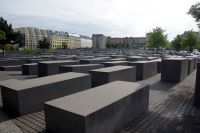 Jewish community of 160,000, whittled down through voluntary exile or involuntary holocaust to around a tenth of that today.
Jewish community of 160,000, whittled down through voluntary exile or involuntary holocaust to around a tenth of that today.
Post World War II is also present, and I can remember some of the episodes as Berlin stood out, transformed from a symbol of Naziism to the reminder to Eastern Europe of the differences between Soviet promises and the West’s reality. One of those symbols was the Berlin blockade (by the Soviets; Berlin was administered by the 4 Allies after World War II, but it was surrounded by the Deutsche Democratic Republic, the Soviet-created and -allied state), raised by non-stop flights of supplies (by the West).
Another was the momentous change that occurred on November 9, 1989, before our students were born, when the Germans tore down the wall that the East German regime had 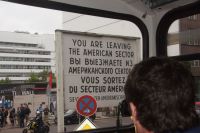 erected in 1961 to keep East Germans from escaping to the west (the East German judges probably gave that move a 10, as they did at the Olympics for any East German athlete). Parts of the wall still remain, artistically painted over with themes of the still elusive peace. Indeed, the reunited Berlin is virtually festooned with artistic monuments dedicated to the future. In fact, one of Professor Pana’s comments is that if you come back in 20 years, you won’t recognize Berlin; the city has almost as many construction projects as Shanghai, befitting Europe’s strongest economy, and I believe, its most populous country.
erected in 1961 to keep East Germans from escaping to the west (the East German judges probably gave that move a 10, as they did at the Olympics for any East German athlete). Parts of the wall still remain, artistically painted over with themes of the still elusive peace. Indeed, the reunited Berlin is virtually festooned with artistic monuments dedicated to the future. In fact, one of Professor Pana’s comments is that if you come back in 20 years, you won’t recognize Berlin; the city has almost as many construction projects as Shanghai, befitting Europe’s strongest economy, and I believe, its most populous country.
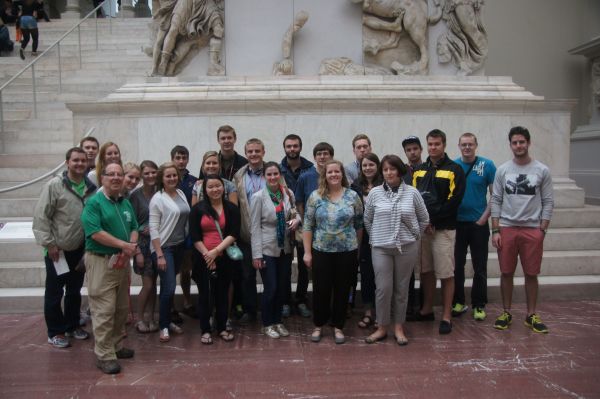
As a great imperial city, Germany has outstanding museums (including museums remembering the Holocaust as well as East Germany, among others). We chose to take the class to the Pergamon Museum, one of the finest collections of the ancient Middle East, the result of German archeologists frequently supported by Kaiser Wilhelm. Wilhelm cultivated the Turks in particular, as a make weight against Russia, and more or less contrived to push Turkey into World War I. If you want to read a fascinating study of his efforts to create a jihad in the Middle East (urging Arabs to avoid killing Germans and Austro-Hungarians), the Berlin-Baghdad Railroad is stranger than fiction.
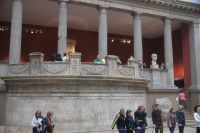 The Pergamon Museum was named for the altar a German archeologist brought back to Berlin from Pergamon, one of the Greek cities on the coast of Turkey. As I told students, Greece’s efforts to create a “European Union” did not result in an imperial Athens, but rather colonies which spread Greek civilization (a move that Alexander took militarily, and the Romans borrowed shamelessly and took with their legions). The museum has some other splendid relics, including another massive structure from Melis, also on the Turkish coast, which resembled the library of Ephesus, but also had a temple dedicated to Trajan and Hadrian, Roman emperors we’ll find active in Athens as well. The Ishtar
The Pergamon Museum was named for the altar a German archeologist brought back to Berlin from Pergamon, one of the Greek cities on the coast of Turkey. As I told students, Greece’s efforts to create a “European Union” did not result in an imperial Athens, but rather colonies which spread Greek civilization (a move that Alexander took militarily, and the Romans borrowed shamelessly and took with their legions). The museum has some other splendid relics, including another massive structure from Melis, also on the Turkish coast, which resembled the library of Ephesus, but also had a temple dedicated to Trajan and Hadrian, Roman emperors we’ll find active in Athens as well. The Ishtar 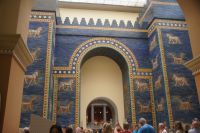 Gate from Babylon is also in the museum—3,000 years old—from the palace of Nebuchadnezzar.
Gate from Babylon is also in the museum—3,000 years old—from the palace of Nebuchadnezzar.
On the way back, we stopped in the Berlin dome, the largest Protestant church in Germany. It’s neo Baroque, built in 1905, and has the distinction of housing the Hohenzollern family graves—not including Wilhelm II, who built it; he fled 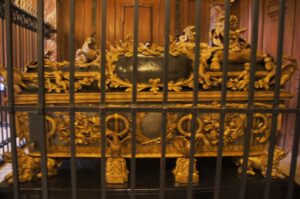 Germany for the Netherlands, and is buried there.
Germany for the Netherlands, and is buried there.
Some of us found our musical program—at the Staatsoper. I saw that the Flying Dutchman was playing last night (part of a 200th year of Wagner’s birth celebration), and went to try to get tickets, only to find it was sold out. There were a few tickets left for a Tchaikovsky ballet, based on Symphonies 5, 6, and Capriccio Italien, which was great fun.
Germany is back in business tomorrow, and so are we. The reunited Germany moved the capital from Bonn in 1991 back to Berlin, which accounts for the efforts we saw today to return Berlin to its place as one of the great cities of the world; and it accounts for our visit to the US embassy, where we’ll be hosted by an IWU alum.